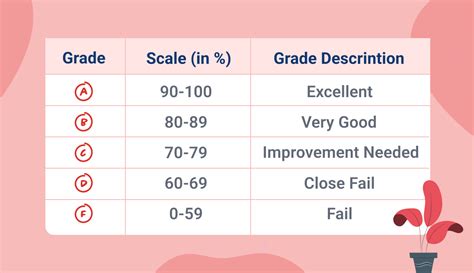Grade Conversion Table
| Letter Grade | Numerical Grade | Percentage |
|---|---|---|
| A+ | 97-100 | 97-100% |
| A | 93-96 | 93-96% |
| A- | 90-92 | 90-92% |
| B+ | 87-89 | 87-89% |
| B | 83-86 | 83-86% |
| B- | 80-82 | 80-82% |
| C+ | 77-79 | 77-79% |
| C | 73-76 | 73-76% |
| C- | 70-72 | 70-72% |
| D+ | 67-69 | 67-69% |
| D | 63-66 | 63-66% |
| D- | 60-62 | 60-62% |
| F | Below 60 | Below 60% |
Step-by-Step Approach to Calculating Grade
- Determine the numerical range associated with each letter grade using the Grade Conversion Table.
- Compare the numerical grade of the student to the ranges of the letter grades.
- The letter grade corresponding to the numerical grade range that includes the student’s numerical grade is the student’s letter grade.
Importance of Letter Grade 80
A grade of 80 in the B- range is considered above average. It indicates that the student has a good understanding of the subject matter and has demonstrated consistent performance.

Benefits of Achieving a Grade 80
- Improved self-confidence and motivation
- Enhanced academic performance in future coursework
- Demonstrated competence in the subject area
- Increased opportunities for educational advancement and career success
Pros and Cons of a Grade 80
Pros:
- Above average performance
- Demonstrates a good understanding of the subject matter
- Provides a solid foundation for future academic success
- Enhances future career prospects
Cons:
- Not as high as an A or A- grade
- May not meet the requirements for certain scholarships or programs
- Requires consistent effort to maintain
Conclusion
A grade of 80 is a solid achievement that represents a good level of understanding and performance in a subject. By understanding the conversion table and its significance, students can track their progress and set realistic goals for academic success.
